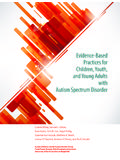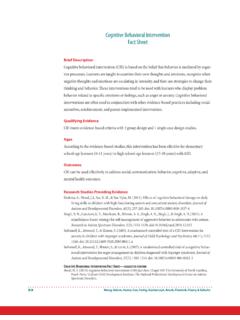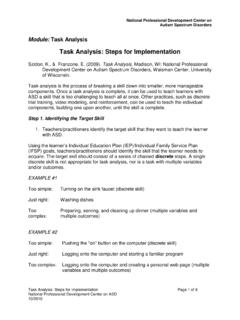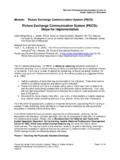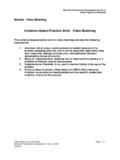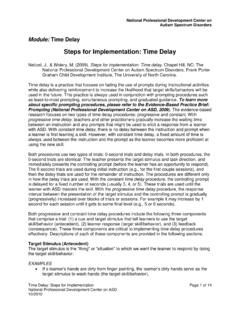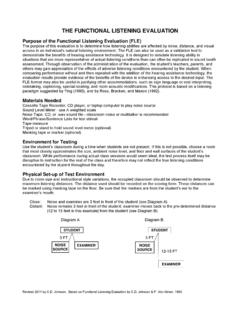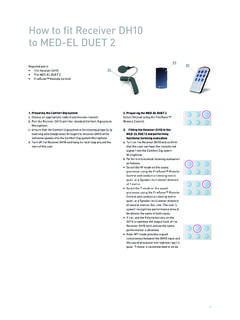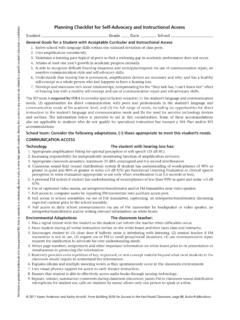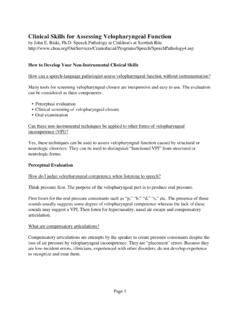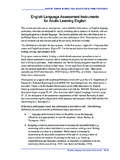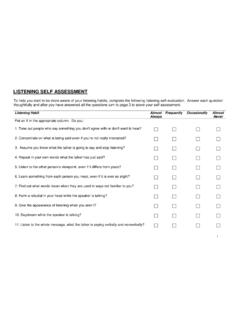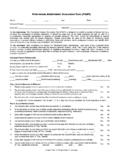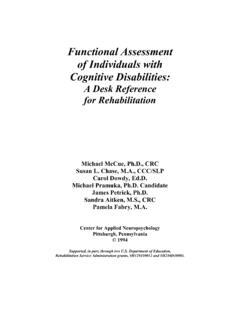Transcription of Implementation Checklist for Functional Behavior Assessment
1 National Professional Development Center on Autism Spectrum Disorders Module: Functional Behavior Assessment Functional Behavior Assessment : Implementation Checklist Page 1 of 9 National Professional Development Center on ASD 10/2010 Implementation Checklist for Functional Behavior Assessment Neitzel, J. (2008). Implementation Checklist for Functional Behavior Assessment . Chapel Hill, NC: The National Professional Development Center on Autism Spectrum Disorders, Frank Porter Graham Child Development Institute, The University of North Carolina. Instructions: The Implementation Checklist includes each phase in the FBA process. Please complete all of the requested information including the site and state, individual being observed/interviewed, and the learner s initials. To assure that a practice is being implemented as intended, an observation is always preferable. This may not always be possible. Thus, items may be scored based on observations with the implementer, discussions and/or record review as appropriate.
2 Within the table, record a 2 (implemented), 1 (partially implemented), 0 (did not implement), or NA (not applicable) next to each step observed to indicate to what extent the step was implemented/addressed during your observation. Use the last page of the Checklist to record the target skill, your comments, whether others were present, and plans for next steps for each observation. Site: _____ State: _____ Individual(s) Observed: _____ Learner s Initials: _____ Skills below can be implemented by a practitioner, parent, or other team member Observation 1 2 3 4 5 6 7 8 Date Observer s Initials Planning ( Steps 1 4 ) Step 1. Establishing a Team Score** 1. A multidisciplinary team is formed that includes: a. the learner s teacher(s), b. any related service personnel ( , speech-language therapist, occupational therapist), c. paraprofessional(s) that work directly with the learner with ASD, d. the learner s parents, and e. the learner (if developmentally appropriate).
3 2. Team members identify the FBA coordinator. **Scoring Key: 2 = implemented; 1 = partially implemented; 0 = did not implement; NA = not applicable National Professional Development Center on Autism Spectrum Disorders Module: Functional Behavior Assessment Functional Behavior Assessment : Implementation Checklist Page 2 of 9 National Professional Development Center on ASD 10/2010 Observation 1 2 3 4 5 6 7 8 Date Observer s Initials Step 2. Identifying the Interfering Behavior Score** 1. Identify the interfering Behavior that is most problematic for the learner that will be the focus of the FBA. 2. After identifying the interfering Behavior , the team members determine: a. how long the Behavior has been interfering with the learner s development and/or learning, b. if the Behavior involves aggression or damage to property, c. if the Behavior is the result of environmental factors ( , lighting, noise level), d.
4 If the interfering is occurring because the learner is being asked to demonstrate a skill that he/she cannot perform, e. when and where the Behavior occurs, f. other behaviors the learner exhibits immediately before the Behavior occurs, and g. what happens immediately after the interfering Behavior occurs. Step 3. Collecting Baseline Data 1. Prior to designing and implementing an intervention, use indirect Assessment methods that include: a. reviewing previous and current records and **Scoring Key: 2 = implemented; 1 = partially implemented; 0 = did not implement; NA = not applicable National Professional Development Center on Autism Spectrum Disorders Module: Functional Behavior Assessment Functional Behavior Assessment : Implementation Checklist Page 3 of 9 National Professional Development Center on ASD 10/2010 Observation 1 2 3 4 5 6 7 8 Date Observer s Initials Step 3. Collecting Data (cont.) Score** b.
5 Conducting formal and informal interviews with school staff, family members, and the learner with ASD. 2. Clearly describe the interfering Behavior and identify data collection measures that will be used to assess the interfering Behavior prior to designing and implementing the intervention. 3. Determine how long baseline data should be collected and who will collect it. 4. Use direct observation methods that generally include: a. using A-B-C data charts, b. using scatterplots, c. using standardized Behavior rating scales, d. conducting learner motivation assessments, and/or e. conducting learner reinforcer preference assessments. 5. Use indirect and direct Assessment results to identify: a. where the Behavior happens, b. with whom the Behavior occurs, c. when the Behavior happens, d. activities during which the Behavior occurs, **Scoring Key: 2 = implemented; 1 = partially implemented; 0 = did not implement; NA = not applicable National Professional Development Center on Autism Spectrum Disorders Module: Functional Behavior Assessment Functional Behavior Assessment : Implementation Checklist Page 4 of 9 National Professional Development Center on ASD 10/2010 Observation 1 2 3 4 5 6 7 8 Date Observer s Initials Step 3.
6 Collecting Data (cont.) Score** e. what other students are doing when the Behavior start, f. what teachers/adults are doing when the Behavior starts, g. proximity of other students, teachers, and/or adults, h. the noise level in the environment, i. the number of individuals in the area, j. other environmental conditions ( , lighting, door open/closed, noise in the hall), and k. the function of the Behavior ( , get/obtain, escape/avoid). 6. Identify other variables that might be influencing the interfering Behavior ( , medication, family/home variables, health status of learner). Step 4. Developing a Hypothesis Statement 1. Develop a hypothesis statement for the interfering Behavior that includes: a. the setting events, the immediate antecedents, and immediate consequences that surround the interfering Behavior , b. a restatement or refinement of the description of the interfering Behavior that is occurring, and **Scoring Key: 2 = implemented; 1 = partially implemented; 0 = did not implement; NA = not applicable National Professional Development Center on Autism Spectrum Disorders Module: Functional Behavior Assessment Functional Behavior Assessment : Implementation Checklist Page 5 of 9 National Professional Development Center on ASD 10/2010 Observation 1 2 3 4 5 6 7 8 Date Observer s Initials Step 4.
7 Developing a Hypothesis Statement (cont.) Score** c. the function the Behavior serves ( , attention, escape, tangible/edibles, automatic/sensory). Intervention ( Steps 5 6 ) Step 5. Testing the Hypothesis 1. Test the hypothesis by modifying the setting/activity to increase the probability that the Behavior occurs. Step 6. Developing Interventions 1. Identify appropriate evidence-based practices that address the function of a learner s interfering Behavior . 2. Develop a Behavior intervention plan (BIP) that matches the function of the interfering Behavior and is agreed upon by all members of the team. 3. Include the following in the BIP: a. a definition of the interfering Behavior , b. evidence-based practices used to decrease the interfering Behavior , c. objectives that can be used to indicate progress, d. additional materials that may be needed ( , data sheet, timer, quiet space, additional staff), **Scoring Key: 2 = implemented; 1 = partially implemented; 0 = did not implement; NA = not applicable National Professional Development Center on Autism Spectrum Disorders Module: Functional Behavior Assessment Functional Behavior Assessment : Implementation Checklist Page 6 of 9 National Professional Development Center on ASD 10/2010 Observation 1 2 3 4 5 6 7 8 Date Observer s Initials Step 6.
8 Developing Interventions (cont.) Score** e. environmental modifications ( , changing class/activity setting, physical attributes of instructional location, change in instructional strategies/practices), f. response(s) from staff and others to the interfering Behavior ( , consequences), g. strategies for improving skill deficit areas, h. strategies for enhancing learner motivation, and i. the data collection plan. Progress Monitoring ( Step 7 ) Step 7. Monitoring Intervention Effectiveness 1. Develop a system to monitor the effectiveness of the intervention that outlines when, where, by whom, and how data are collected. 2. Collect data that focus on: a. the frequency of the interfering Behavior , b. the frequency of use of replacement Behavior (s), and c. how long the interfering Behavior lasts when it occurs. 3. Collect data in the setting where the Behavior occurs and in other settings as well.
9 **Scoring Key: 2 = implemented; 1 = partially implemented; 0 = did not implement; NA = not applicable National Professional Development Center on Autism Spectrum Disorders Module: Functional Behavior Assessment Functional Behavior Assessment : Implementation Checklist Page 7 of 9 National Professional Development Center on ASD 10/2010 Observation 1 2 3 4 5 6 7 8 Date Observer s Initials Step 7. Monitoring Intervention Effectiveness (cont.) Score** 4. Collect data in the setting in which the Behavior occurs at least once a week to monitor the frequency of the interfering Behavior (s) and the replacement Behavior (s). 5. Compare intervention data to baseline data to determine the effectiveness of the intervention. 6. Summarize the data to make decisions about program planning. **Scoring Key: 2 = implemented; 1 = partially implemented; 0 = did not implement; NA = not applicable National Professional Development Center on Autism Spectrum Disorders Module: Functional Behavior Assessment Functional Behavior Assessment : Implementation Checklist Page 8 of 9 National Professional Development Center on ASD 10/2010 Date Observer Initials Target Skill/ Behavior , Comments, and Plans for Next Steps Date Observer Initials Target Skill/ Behavior , Comments, and Plans for Next Steps Date Observer Initials Target Skill/ Behavior , Comments, and Plans for Next Steps Date Observer Initials Target Skill/ Behavior , Comments, and Plans for Next Steps National Professional Development Center on Autism Spectrum Disorders Module: Functional Behavior Assessment Functional Behavior Assessment .
10 Implementation Checklist Page 9 of 9 National Professional Development Center on ASD 10/2010 Date Observer Initials Target Skill/ Behavior , Comments, and Plans for Next Steps Date Observer Initials Target Skill/ Behavior , Comments, and Plans for Next Steps Date Observer Initials Target Skill/ Behavior , Comments, and Plans for Next Steps Date Observer Initials Target Skill/ Behavior , Comments, and Plans for Next Steps
